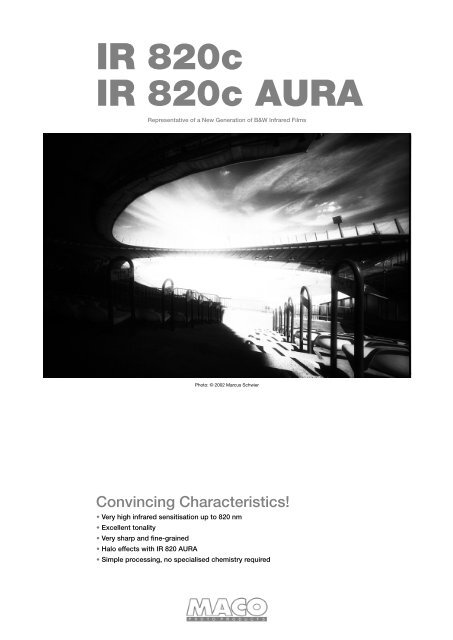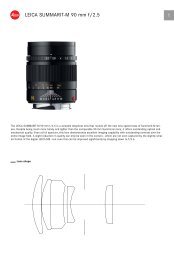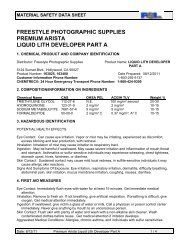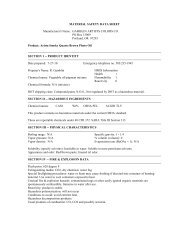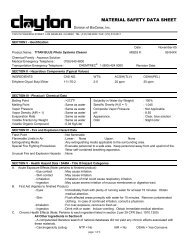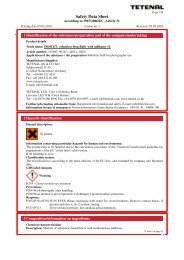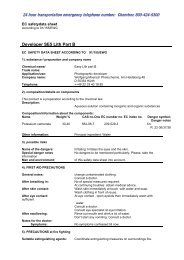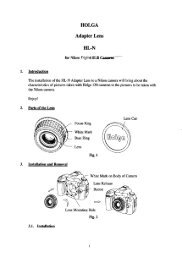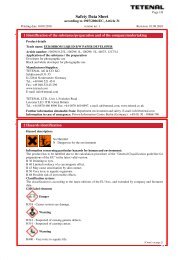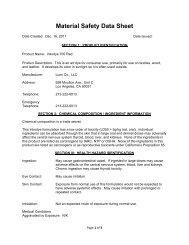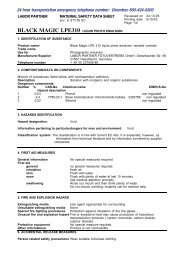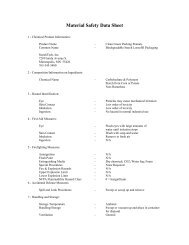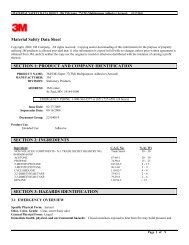IR 820c IR 820c AURA - HANS O. MAHN & CO. KG
IR 820c IR 820c AURA - HANS O. MAHN & CO. KG
IR 820c IR 820c AURA - HANS O. MAHN & CO. KG
You also want an ePaper? Increase the reach of your titles
YUMPU automatically turns print PDFs into web optimized ePapers that Google loves.
<strong>IR</strong> <strong>820c</strong><br />
<strong>IR</strong> <strong>820c</strong> <strong>AURA</strong><br />
Representative of a New Generation of B&W Infrared Films<br />
Photo: © 2002 Marcus Schwier<br />
Convincing Characteristics!<br />
• Very high infrared sensitisation up to 820 nm<br />
• Excellent tonality<br />
• Very sharp and fine-grained<br />
• Halo effects with <strong>IR</strong> 820 <strong>AURA</strong><br />
• Simple processing, no specialised chemistry required
2<br />
<strong>IR</strong><strong>820c</strong> / <strong>IR</strong><strong>820c</strong> <strong>AURA</strong><br />
Tech. Support (040) 237008-88 · Fax (040) 237008-488 · E-Mail photo@mahn.net · Internet www.mahn.net<br />
Karel Novotny was born in the Czech Republic in 1972.<br />
He studied at the Bohemian Technical University to become a construction<br />
engineer. Already when he was a small child, at the tender<br />
age of 5, his grandfather taught him the basics of photography and<br />
kindled his love for it. In his free time, Karel Novotny photographs the<br />
Czech countryside (see the images in this brochure), still lives and<br />
nudes. In his own darkroom, he makes impressive prints. His preferred<br />
cameras are a Mamiya 23 Press (6 x 9 cm), a Globica sheet<br />
film camera (18 x 24 cm), and Nikon Fm and F80 cameras for the studio.<br />
Karel Novotny is also open to digital photography, for which he<br />
uses a Fuji S2 Pro camera. In the past, he kept using Czech-made<br />
FOMA films, but through friends and contacts in the West he became<br />
acquainted with, and grew to love, MA<strong>CO</strong> films. Karel Novotny found<br />
his way to work with MA<strong>CO</strong> <strong>IR</strong> <strong>820c</strong> without any additional information.<br />
As a result, we see impressive images reflecting his love for<br />
nature. Based on the excellent quality of his work and the self-taught<br />
background knowledge, he published a comprehensive technical<br />
article in a Czech photography journal in 2003.<br />
e-mail: kardan.melnik@quick.cz<br />
Photo: © 2004 Karel Novotny, Melnik<br />
01_Characteristics and Application<br />
MA<strong>CO</strong> <strong>IR</strong> <strong>820c</strong> and MA<strong>CO</strong> <strong>AURA</strong> are medium-speed black-and-white<br />
films with panchromatic sensitisation and infrared sensitisation up to<br />
850 nm. This infrared (<strong>IR</strong>) sensitisation, reaching far beyond the visible<br />
range, allows for strong <strong>IR</strong> effects (black sky, Wood effect). The<br />
basic me-dium-speed emulsion makes for fine grain and excellent<br />
gradation as well as high resolving power. While MA<strong>CO</strong> <strong>IR</strong> <strong>820c</strong> is<br />
provided with an anti-halation (AH) backing that effectively re-duces<br />
light scattering in the emulsion and im-proves sharpness, this AH<br />
backing was omitted in the MA<strong>CO</strong> <strong>AURA</strong> in order to create halos (or<br />
auras) which are often desired in <strong>IR</strong> photography.<br />
MA<strong>CO</strong> <strong>IR</strong> <strong>820c</strong> and MA<strong>CO</strong> <strong>AURA</strong> lend them-selves to all kinds of<br />
pictorial applications, such as architecture, landscape, portrait, to<br />
name just a few. These films can be processed in all types of blackand-white<br />
developers. The clear base allows application as blackand-white<br />
slide film. The polyester base used for medium-format and<br />
cut sheet film offers the highest standard in terms of archival stability.<br />
02_Available Formats<br />
35-mm film 135-36<br />
MF roll film 120<br />
Cut sheet film 4 x 5 in 25 sheets<br />
8 x 10 in 25 sheets
05_Loading of Camera<br />
MA<strong>CO</strong> PHOTO PRODUCTS Hans O. Mahn & Co. <strong>KG</strong> · D-22145 Hamburg-Stapelfeld · Brookstieg 4<br />
03_Technical Data<br />
Sensitisation<br />
panchromatic, approx. 380 nm to 820 nm<br />
Speed<br />
depending on developer<br />
ISO 100/21° to ISO 200/24° for daylight<br />
ISO 50/18° to ISO 100/21° for tungsten light<br />
Base material<br />
• 35 mm (135) film: Cellulose triacetate, clear, 130 µm<br />
• 120 roll film: Polyester, clear, 100 µm<br />
• Cut sheet film: Polyester, clear, 175 µm<br />
Resolving power<br />
110 Lp/mm at a contrast of 1:1 000<br />
Processing<br />
in complete darkness<br />
04_Storage of Film Material<br />
The sensitisation dyes used in <strong>IR</strong> films are not as stable as those used<br />
in panchromatic films, the life of the dyes being the shorter the longer<br />
the cut-off wavelength. Consequently, storage under unfavourable<br />
conditions can result in a slow, continuous loss of the <strong>IR</strong> sensitisation.<br />
For intermediate to long-term storage of <strong>IR</strong> films, storage at a<br />
temperature of no more than 4 °C (39 °F) is recommended. Films can<br />
be deep-frozen at -18 °C (0 °F; *** section of household refrigerators<br />
or freezers).<br />
Films that were stored under refrigeration should be allowed to reach<br />
thermal equilibrium with the environment before being taken from the<br />
storage container. When the film is considerably colder than the ambient<br />
air, condensate may form on its surface.<br />
120 roll film should be loaded into the camera or camera<br />
back under subdued light.<br />
Complete darkness is required when loading 35-mm cartridges<br />
into cameras and when loading cut sheet film<br />
backs.<br />
It is technically impossible to seal the felt trap of a 35-mm cartridge<br />
against <strong>IR</strong> radiation. Also, the film base will act as an optical waveguide<br />
for <strong>IR</strong> radiation. It is because of these facts that MA<strong>CO</strong> <strong>IR</strong> <strong>820c</strong><br />
and MA<strong>CO</strong> <strong>AURA</strong> 35-mm films must be taken from the storage container<br />
and loaded into the camera in complete darkness (i.e. in a<br />
changing bag or in a darkroom). Films taken from the container under<br />
light (daylight or artificial) can be expected to be fogged up to about<br />
half the film length (frame 12 to 18).<br />
06_Exposure and Speed<br />
Infrared (<strong>IR</strong>) radiation with wavelengths in excess of a little more than<br />
700 nm is not visible to the human eye.<br />
For daylight (5400 K) MA<strong>CO</strong> <strong>IR</strong> <strong>820c</strong> and MA<strong>CO</strong> <strong>AURA</strong> have a speed<br />
of ISO 100/21° (ISO 200/24°) in special speed-increasing developers.<br />
As the sensitivity to light at longer wavelengths (red light) is higher<br />
than in conventional panchromatic films (see sensitisation curves at<br />
annex) it is recommended to use a somewhat higher effective speed<br />
under tungsten light, and also when the sun is low above the horizon.<br />
When no exposure meter is available, the following values may be<br />
used for guidance. In this case, it is recommended to bracket from<br />
one f-stop below the value given in the table to one f-stop above.<br />
Sunshine in mountains 1/125, f/22<br />
Beach or snowy landscape in bright sun 1/125, f/22<br />
Bright sun (so-called »Sunny 16 Rule«) 1/125, f/16<br />
Sunshine and haze 1/125, f/11<br />
Cloudy, sun shining 1/125, f/5,6<br />
Cloudy, open shade 1/125, f/5,6<br />
MA<strong>CO</strong> <strong>IR</strong> <strong>820c</strong>, no filter Photo: © Valsasnini<br />
MA<strong>CO</strong> <strong>IR</strong> <strong>820c</strong>, Heliopan RG 715 filter Photo: © Valsasnini<br />
Photographs and Captions: © 2002 »Schroeders Negativ-Praxis«<br />
3
4<br />
<strong>IR</strong><strong>820c</strong> / <strong>IR</strong><strong>820c</strong> <strong>AURA</strong><br />
Tech. Support (040) 237008-88 · Fax (040) 237008-488 · E-Mail photo@mahn.net · Internet www.mahn.net<br />
07_Exposure Metering<br />
What Does the Film »See«?<br />
The term »light« or »visible light« denotes that range of electromagnetic<br />
radiation, which can be used for imaging by the human eye.<br />
Electromagnetic radiation exhibits wave-like behaviour, its physics<br />
is described in terms of wavelengths. Humans can see light with<br />
wavelengths ranging between approximately 400 nm up to a little<br />
more than 700 nm. Light with a certain wavelength produces the<br />
impression of a specific colour. So the visible spectrum extends from<br />
violet (400 nm) via indigo, blue, green, yellow, and orange to red (700<br />
nm). The range with wavelengths below 400 nm is called ultraviolet<br />
(UV, beyond violet), the one with wavelengths above 700 nm is called<br />
infrared (<strong>IR</strong>, below red). Strictly speaking, UV and <strong>IR</strong> »light« is not<br />
really light, but electromagnetic (EM) radiation, because the eye is<br />
blind to these »colours«. So if only UV- and/or <strong>IR</strong> radiation are present,<br />
the eye will »see« complete darkness. (MA<strong>CO</strong> <strong>IR</strong> <strong>820c</strong> and MA<strong>CO</strong><br />
<strong>AURA</strong>, however, will still »see«.)<br />
Like all <strong>IR</strong> films, MA<strong>CO</strong> <strong>IR</strong> <strong>820c</strong> and MA<strong>CO</strong> <strong>AURA</strong> are also sensitive<br />
to visible light. The sensitivity to visible light being higher than that<br />
for <strong>IR</strong> radiation, and radiation being less abundant, no significant <strong>IR</strong><br />
effect will be observable in daylight or artificial-light shots as the<br />
image generated by visible light is much stronger than that generated<br />
by <strong>IR</strong> radation. So, in order to obtain images exhibiting the typical<br />
»<strong>IR</strong> effect«, i.e. dark or black skies and brilliant white foliage, it is<br />
necessary to block out most of the visible light by means of filters.<br />
Filters for use in <strong>IR</strong> photography typically block all light with a wavelength<br />
below a specified »cut-off wavelength« while being practically<br />
completely transparent for light at longer wavelengths. The choice<br />
of the cut-off wavelength allows to control the amount of visible light<br />
contributing to image formation, which means it controls the effect<br />
afforded by the filter. The following filters typically used in <strong>IR</strong> photography<br />
are sorted in order of increasing cut-off wavelength:<br />
• Gelb (Kodak Wratten #8 und #15)<br />
• Yellow (Kodak Wratten #8 and #15)<br />
• Orange (Kodak Wratten #21 and #22)<br />
• Red (Kodak Wratten #25 and #29)<br />
• RG 645<br />
• RG 665<br />
• RG 695 (Kodak Wratten 89B)<br />
• RG 715 (Kodak Wratten 88A)<br />
• Kodak Wratten #87<br />
The RG 695 (89B) filter allows so little visible light to pass that viewing<br />
a scene through such a filter, the human eye will only see a very<br />
dim, deep red image. Filters RG 715 (88A) and above are completely<br />
opaque for most humans. The cut-off wavelength of even stronger<br />
filters such as 87C (cutting off at about 830 nm) lies so high that these<br />
filters are also opaque for MA<strong>CO</strong> <strong>IR</strong> <strong>820c</strong> and MA<strong>CO</strong> <strong>AURA</strong>. Such<br />
filters are therefore not suitable for use with these films.<br />
Measurement and Interpretation of Measured Data<br />
Exposure meters are calibrated for visible light and may not react in<br />
a standardized way when exposed to <strong>IR</strong> radiation. While some meters<br />
are »blind« to <strong>IR</strong> radiation, others will measure it without problems.<br />
This means that every user will have to establish their own empirical<br />
data. It also implies that the data given below is to be understood as<br />
being uncertain to some degree. It should be used for guidance only.<br />
If no empirical data exists concerning the measurement of <strong>IR</strong> radiation<br />
with a given meter, it is recommended to bracket extensively<br />
around the reference values given below. This method will initially<br />
cost some film, but will give you the experience that will later allow<br />
you to evaluate the lighting situation with a high degree of certainty.<br />
It is convenient to keep detailed records of the lighting situation (such<br />
as season; position of sun: high/low, direction; cloud coverage) for<br />
evaluation together with the negatives.<br />
It is also recommended to include one unfiltered shot in<br />
each bracketed series in order to be able to rule out<br />
processing errors as the source of error where unexpected<br />
results are obtained. For this shot, expose the<br />
film as you would expose panchromatic film with a speed<br />
of ISO 100/21°.<br />
For exposures with filters, various methods of measurement are<br />
available.<br />
∞<br />
Incident-light Metering<br />
Incident light is measured at a point within the subject, or at a point<br />
receiving similar lighting, while pointing the exposure meter towards<br />
the camera. It aims at measuring all light incident upon the subject.<br />
For details of performing incident-light measurements using your<br />
exposure meter, please refer to the manual of your exposure meter.<br />
For this type of measurements, set your exposure meter to an effective<br />
film speed in which the filter factor has been taken into account.<br />
∞<br />
Reflected-light Metering Without Filter<br />
When the light reflected by the subject is measured, the reflectivity<br />
of the subject will influence the measurement. This type of measurements<br />
can be performed using hand-held or built-in camera exposure<br />
meters. For details of performing reflected-light measurements<br />
using your exposure meter, please refer to the manual of your exposure<br />
meter or camera. For this type of measurements, when using<br />
TTL (i.e. through-the-lens metering) make sure that no filter is mounted<br />
on the lens while metering. Set your exposure meter to an effective<br />
film speed in which the filter factor has been taken into account.
MA<strong>CO</strong> PHOTO PRODUCTS Hans O. Mahn & Co. <strong>KG</strong> · D-22145 Hamburg-Stapelfeld · Brookstieg 4<br />
Heliopan opaque 715 Photo: © 2004 Marcus Schwier<br />
Hoya HMC filter, orange G Photo: © 2004 Marcus Schwier<br />
TTL Metering With Filter<br />
Filters that are still fairly transparent to visible light, such as yellow,<br />
orange, and red filters, allow for TTL metering with the filter placed<br />
on the lens. In this case, set your camera meter to the film's nominal<br />
speed (i.e. ISO 100/21°). A correction of the measured values is<br />
not usually needed.<br />
When measuring using a hand-held exposure meter, the indicated<br />
exposures must be multiplied by the factors listed in the table below.<br />
Alternatively, the diaphragm must be opened by the number of fstops<br />
given. (In brackets: Kodak Wratten designation.)<br />
Multiply exposure Open f-stop by this<br />
Filter time by this factor number of stops<br />
Yellow (#8) 1,5 to 2 ¹⁄₂ to 1<br />
Dark yellow (#15) 2 1<br />
Yellow/green (#11) 3 bis 4 1 bis 2<br />
Orange (#21) 3 bis 4 1 bis 2<br />
Red (#25) 4 bis 8 2 bis 3<br />
Dark red (#29) 4 bis 16 3 bis 4<br />
RG 645 16 4<br />
RG 665 16 4<br />
RG 695 (#89B) 16 4<br />
RG 715 (#88A) 32 5<br />
RG 780 (#87) 32 5<br />
RG 830 (#87C) and higher not recommended<br />
These values apply to daylight exposures. Tungsten light contains<br />
more red light than daylight. Consequently, yellow, orange, and red<br />
filters block out a slightly smaller portion of it.<br />
Reducing the extension factors for the exposure times by 0,2 to 0,5<br />
or reducing the f-stop correction by ¹⁄₃ to ¹⁄₂ stop is recommended in<br />
such cases.<br />
Hoya HMC filter, red #25A Photo: © 2004 Marcus Schwier<br />
Hoya HMC filter, yellow K2 Photo: © 2004 Marcus Schwier<br />
Effective Film Speed<br />
The following speeds are intended as guidance for your own experimentation.<br />
Different exposure meters tend to react differently to <strong>IR</strong><br />
radiation. It will therefore be necessary to modify these values based<br />
on experience gathered during your first own exposures. The values<br />
given in the table below apply to measurements without filter, and<br />
exposures with filter. The exposure recommended by the exposure<br />
meter is then used without further adjustments. (In brackets: Kodak<br />
Wratten designation.)<br />
Filter Set exposure meter to this speed<br />
Yellow (#8) ISO 64/19° to ISO 50/18°<br />
Dark yellow (#15) ISO 50/18°<br />
Yellow/green (#11) ISO 50/18° to ISO 25/15°<br />
Orange (#21) ISO 50/18° to ISO 25/15°<br />
Red (#25) ISO 25/15° to ISO 12/12°<br />
Dark red (#29) ISO 25/15° to ISO 6/9°<br />
RG 645 ISO 6/9°<br />
RG 665 ISO 6/9°<br />
RG 695 (#89B) ISO 6/9°<br />
RG 715 (#88A) ISO 6/9° to ISO 3/6°<br />
RG 780 (#87) ISO 6/9° to ISO 3/6°<br />
RG 830 (#87C) and higher not recommended<br />
5
6<br />
<strong>IR</strong><strong>820c</strong> / <strong>IR</strong><strong>820c</strong> <strong>AURA</strong><br />
Tech. Support (040) 237008-88 · Fax (040) 237008-488 · E-Mail photo@mahn.net · Internet www.mahn.net<br />
Focusing<br />
The glass used to make lenses refracts light at different wavelenghts<br />
to different extents. The focal length of a lens is longer for red light<br />
than for blue light. This is called longitudinal chromatic aberration<br />
(LCA). Lens manufacturers try to correct this aberration by combining<br />
different sorts of glass in multi-lens systems in such a way as to<br />
focus all visible light in one focal point, if possible. However, lenses<br />
are primarily corrected for visible light. The corrected range is widest<br />
for so-called apochromatic lenses, but even in these the correction<br />
is a priori only valid for visible light. It is not to be taken for granted<br />
that it also holds for <strong>IR</strong> radiation.<br />
Most lenses have an "<strong>IR</strong>" mark in addition to the usual focusing mark<br />
on their focusing ring. Using this mark is recommended if the image<br />
is indeed dominated by <strong>IR</strong> radiation, i.e. when using visually opaque<br />
filters (RG 695/89B and higher). If your lens does not bear an "<strong>IR</strong>"<br />
mark (as is the case in many modern autofocus lenses), the proper<br />
focus adjustment must be found empirically. For your first experiments,<br />
use the innermost mark on the depth of field scale of your<br />
lens. When focusing for <strong>IR</strong> radiation, focus to a slightly closer distance<br />
than for visible light.<br />
Where the image on the film is created by a mixture containing significant<br />
amounts of visible light (i.e. when using one of the visibly<br />
transparent yellow, orange, or red filters), an adjustment is not usually<br />
needed. This is particularly true if shooting at large apertures and<br />
large focal lengths is avoided. When short focal lengths are used (35<br />
mm and shorter for 35-mm film) a focus adjustment is not usually<br />
necessary due to the depth of field.<br />
∞<br />
Reciprocity Error<br />
The reciprocity law, stating that the exposure will remain the same<br />
when the shutter speed is doubled and the aperture closed by one<br />
f-stop, is only true for films where shutter speeds are neither too short<br />
nor too long, typically between 1/2 s and 1/1 000 s. Whenever exposure<br />
times are very long, the so-called reciprocity error, or<br />
Schwarzschild effect, is encountered. Where the exposure meter indicates<br />
an exposure time of, e.g. 4 s, the time actually needed can be<br />
assumed to lie between 8 and 10 s. The following corrections may<br />
be used for guidance.<br />
Time measured [s] Time actually required [s]<br />
1 1 to 2<br />
2 3 to 4<br />
4 8<br />
8 24<br />
15 60<br />
30 180<br />
In case of important images, the photographer should expose one<br />
frame at the selected f-stop and the corrected exposure time, and<br />
two more frames at the same exposure time, one each with the aperture<br />
closed and opened by one f-stop with respect to the first frame.<br />
Bracketing by adjusting the aperture has the advantage of not requiring<br />
a new calculation of exposure time.<br />
Reciprocity error will result in increased contrast as the corrections<br />
for highlights are less than those for shadows. Films with long exposure<br />
times will therefore often profit from compensating development,<br />
as, e.g., with LP-SUPERGRAIN.<br />
07_Known Problems (and Myths)<br />
<strong>IR</strong> LEDs for Frame Counting<br />
Some modern cameras, like certain Canon EOS and Nikon models,<br />
do not use mechanical means to control film advance, but count<br />
<strong>IR</strong>-emitting LEDs. For some camera models such as the Hasselblad<br />
XPan, the manufacturer even offers modifications of the camera to<br />
enable the use with <strong>IR</strong> film. The <strong>IR</strong> radiation emitted by these LEDs<br />
lies in a range where conventional, panchromatic films are »blind«.<br />
<strong>IR</strong> films, however, can be fogged by it. Please contact the manufacturer<br />
of your camera, enquiring whether or not your specific camera<br />
model uses such a frame-counting device.<br />
∞<br />
Film Windows in Camera Backs<br />
Due to the lack of an anti-halation backing in MA<strong>CO</strong> <strong>AURA</strong>, it is<br />
possible that light penetrating the film and being reflected by the<br />
pressure plate exposes the film. In general, this will only be a<br />
problem if the pressure plate has features like a pattern of dimples,<br />
windows for printing data, etc. It has proven useful in such cases to<br />
cover the pressure plate with a thin and smooth black material, like<br />
the protective paper of a 120 roll film. However, in some cases, this<br />
may increase the drag to be overcome for film advance.<br />
The effect can also be exploited creatively. Covering the pressure<br />
plate with reflective material, e.g. aluminium foil, will enhance<br />
halation, especially in the highlights, and slightly increases contrast.<br />
∞<br />
Bellows<br />
Intact bellows of modern medium- or large-format cameras are<br />
<strong>IR</strong>-safe. Leakage problems may arise with thin bellows of antique<br />
cameras.<br />
∞<br />
Film Pressure Plate<br />
Due to the lack of an anti-halation backing in MA<strong>CO</strong> <strong>AURA</strong>, it is possible<br />
that light penetrating the film and being reflected by the pressure<br />
plate exposes the film. In general, this will only be a problem if<br />
the pressure plate has features like a pattern of dimples, windows<br />
for printing data, etc. It has proven useful in such cases to cover the<br />
pressure plate with a thin and smooth black material, like the protective<br />
paper of a 120 roll film. However, in some cases, this may<br />
increase the drag to be overcome for film advance.<br />
The effect can also be exploited creatively. Covering the pressure<br />
plate with reflective material, e.g. aluminium foil, will enhance halation,<br />
especially in the highlights, and slightly increases contrast.<br />
∞<br />
Plastic Cameras and Development Tanks<br />
Reports that cameras with bodies made of plastics are not <strong>IR</strong>-safed<br />
have not been substantiated to date. It could be shown, however,<br />
that the bodies of, e.g., Minox 35 cameras (thin makrolon) and the<br />
Russian panoramic camera Horizon 202 are perfectly suitable for use<br />
with <strong>IR</strong> film. The same holds for development tanks.<br />
All steel tanks are suitable for developing <strong>IR</strong> films. The same could<br />
be shown for the development tanks of JOBO, which are made of<br />
makrolon. Problems with other brands are not anticipated. Should<br />
you fear that your tank is not <strong>IR</strong>-safe, it is recommended [1] that you<br />
wrap it in aluminum foil.<br />
∞<br />
Textile Shutter Curtains<br />
Literature sometimes advises owners of cameras with focal-plane<br />
shutters with textile curtains to change lenses in subdued light.<br />
However, reports of problems could not be substantiated.<br />
[1] Rudolf Hillebrand, Infrarot — Fotografie auf anderer Wellenlänge<br />
ISBN 3-7231-0019-8
Density<br />
3,00<br />
2,50<br />
2,00<br />
1,50<br />
1,00<br />
0,50<br />
MA<strong>CO</strong> PHOTO PRODUCTS Hans O. Mahn & Co. <strong>KG</strong> · D-22145 Hamburg-Stapelfeld · Brookstieg 4<br />
08_X-ray Baggage Check at Airports<br />
X-ray machines at airports, when labelled »filmsafe«, could be shown<br />
not to have any detrimental effect on films, even in case of multiple<br />
exposures (up to 5 times). Fogging during manual checking is much<br />
more likely, though, as the film is taken out of the canister and<br />
exposed to light (see Clause 5). Problems must also be expected<br />
when films are transported in checked baggage. The intensity used<br />
to x-ray this piece of luggage will be increased automatically if it contains<br />
any object that is not easily penetrated by low-intensity x-rays<br />
(such as a.c. adaptors of electronic devices). The higher dose used<br />
in this case may not be film-safe any more. It is therefore recommended<br />
to transport films in your cabin luggage.<br />
Characteristic Curve<br />
0,00<br />
0,0 0,3 0,6 0,9 1,2 1,5 1,8 2,1<br />
log Hrel 2,4 2,7 3,0 3,3 3,6 3,9 4,2<br />
09_Processing<br />
Loading of the Film into the Development Tank<br />
As was mentioned in Clause 5, the 35-mm film cartridge must never<br />
be exposed to light. This also applies to the light emitted by darkroom<br />
safelights. Only open the film canister in a completely dark darkroom<br />
or changing bag.<br />
120 roll film and sheet film must be processed<br />
in complete darkness.<br />
Prewashing/presoaking<br />
MA<strong>CO</strong> <strong>IR</strong> <strong>820c</strong> has a clear base and a water-soluble anti-halation<br />
(AH) backing. In order to remove this backing, for higher actual speed,<br />
and for more uniform development, it is recommended to presoak<br />
films for 30 s in tap water prior to development. Agitation should not<br />
be excessive (Invert once every 2,5 to 3 s.), and use water at approximately<br />
the same temperature as that intended for subsequent processing<br />
steps.<br />
Note: Having resolved the water-soluble AH backing, the wash water<br />
will be deep blue when poured out of the tank. This is normal. One<br />
washing cycle, as described above, is sufficient. It is not required to<br />
wash until the wash water does not show any more signs of dyes.<br />
10_Developers and Developing Times<br />
The development times given below are approximate starting values<br />
for optimisation by the user. They were determined for a gamma of<br />
0,65 as considered convenient for enlargers with diffuse lighting systems.<br />
The particular way in which the user develops may require these<br />
values to be modified.<br />
The developer will also affect film speed. Deviations from the nominal<br />
speed of ISO 100/21° are noted.<br />
Development times chart<br />
Unless otherwise specified, the recommendations apply to a<br />
processing temperature of 20 °C and one inversion every 30 s.<br />
Developer Developing Time [min]<br />
LP-DOCUFINE LC 1+4 8<br />
LP-SUPERGRAIN 1+7 5<br />
LP-CUBE XS 1+4 14 (24°C) (Speed ISO 50/18°)<br />
Ilford ID 11 Stock 7<br />
Ilford Microphen Stock 7 (Speed ISO 200/24°)<br />
Ilford Perceptol Stock 9 (Speed ISO 50/18°)<br />
Kodak D-76 Stock 7<br />
Kodak HC-110 Dil. B 5<br />
Kodak T-max 1+4 6<br />
Kodak Xtol 1+2 16<br />
Tetenal Ultrafin 1+10 7 (invert every 3 s)<br />
Tetenal Ultrafin 1+20 9 (invert every 3 s)<br />
7
8<br />
<strong>IR</strong><strong>820c</strong> / <strong>IR</strong><strong>820c</strong> <strong>AURA</strong><br />
Tech. Support (040) 237008-88 · Fax (040) 237008-488 · E-Mail photo@mahn.net · Internet www.mahn.net<br />
11_The Effect of Temperature on Processing Time<br />
Generally, where a high degree of reproducibility is required, it is<br />
recommended to process all films at the same temperature, usually<br />
20 °C (68 °F). Where other temperatures must be used, the following<br />
corrections are recommended. Starting from the time at 20 °C<br />
(68 °F; grey column), seek the corrected time in the column for the<br />
actual processing temperature. (All values are given in minutes.)<br />
18°C 19°C 20°C 21°C 22°C 24°C<br />
5 4 ¹⁄₂ 4 3 ¹⁄₂ 3 ¹⁄₄ 2 ¹⁄₂<br />
5 ¹⁄₂ 5 4 ¹⁄₂ 4 3 ³⁄₄ 3<br />
6 5 ¹⁄₂ 5 4 ¹⁄₂ 4 3 ¹⁄₄<br />
6 ¹⁄₂ 6 5 ¹⁄₂ 5 4 ¹⁄₂ 3 ¹⁄₂<br />
7 ¹⁄₄ 6 ¹⁄₂ 6 5 ¹⁄₂ 5 4<br />
8 7 ¹⁄₄ 6 ¹⁄₂ 6 5 ¹⁄₄ 4 ¹⁄₂<br />
8 ³⁄₄ 7 ³⁄₄ 7 6 ¹⁄₂ 5 ³⁄₄ 5<br />
9 ¹⁄₄ 8 ¹⁄₄ 7 ¹⁄₂ 6 ³⁄₄ 6 5 ¹⁄₄<br />
9 ³⁄₄ 8 ³⁄₄ 8 7 ¹⁄₄ 6 ¹⁄₂ 5 ¹⁄₂<br />
10 ¹⁄₂ 9 ¹⁄₂ 8 ¹⁄₂ 7 ³⁄₄ 7 6<br />
11 ¹⁄₄ 10 9 8 7 ¹⁄₄ 6 ¹⁄₄<br />
11 ³⁄₄ 10 ¹⁄₂ 9 ¹⁄₂ 8 ¹⁄₂ 7 ³⁄₄ 6 ¹⁄₄<br />
12 ¹⁄₂ 11 ¹⁄₄ 10 9 8 7<br />
13 11 ³⁄₄ 10 ¹⁄₂ 9 ¹⁄₂ 8 ¹⁄₂ 7 ¹⁄₄<br />
13 ³⁄₄ 12 ¹⁄₄ 11 10 9 7 ¹⁄₂<br />
14 ¹⁄₄ 12 ³⁄₄ 11 ¹⁄₂ 10 ¹⁄₂ 9 ¹⁄₄ 8<br />
14 ³⁄₄ 13 ¹⁄₄ 12 10 ³⁄₄ 9 ³⁄₄ 8 ¹⁄₄<br />
15 ¹⁄₄ 13 ³⁄₄ 12 ¹⁄₂ 11 ¹⁄₄ 10 8 ³⁄₄<br />
16 14 ¹⁄₂ 13 11 ³⁄₄ 10 ¹⁄₂ 9<br />
16 ³⁄₄ 15 13 ¹⁄₂ 12 11 9 ¹⁄₄<br />
17 ¹⁄₄ 15 ¹⁄₂ 14 12 ¹⁄₂ 11 ¹⁄₄ 9 ³⁄₄<br />
17 ³⁄₄ 16 14 ¹⁄₂ 13 11 ³⁄₄ 10<br />
18 ¹⁄₂ 16 ³⁄₄ 15 13 ¹⁄₂ 12 ¹⁄₄ 10 ¹⁄₂<br />
19 ¹⁄₄ 17 ¹⁄₄ 15 ¹⁄₂ 14 12 ³⁄₄ 10 ³⁄₄<br />
19 ³⁄₄ 17 ³⁄₄ 16 14 ¹⁄₂ 13 11<br />
20 ¹⁄₂ 18 ¹⁄₂ 16 ¹⁄₂ 14 ³⁄₄ 13 ¹⁄₂ 11 ¹⁄₂<br />
21 19 17 15 ¹⁄₄ 13 ³⁄₄ 11 ³⁄₄<br />
21 ³⁄₄ 19 ¹⁄₂ 17 ¹⁄₂ 15 ³⁄₄ 14 ¹⁄₄ 12<br />
22 ¹⁄₄ 20 18 16 ¹⁄₄ 14 ¹⁄₂ 12 ¹⁄₂<br />
22 ³⁄₄ 20 ¹⁄₂ 18 ¹⁄₂ 16 ³⁄₄ 15 12 ³⁄₄<br />
23 ¹⁄₂ 21 19 17 ¹⁄₄ 15 ¹⁄₂ 13 ¹⁄₄<br />
24 ¹⁄₄ 21 ³⁄₄ 19 ¹⁄₂ 17 ¹⁄₂ 16 13 ¹⁄₂<br />
24 ³⁄₄ 22 ¹⁄₄ 20 18 16 ¹⁄₄ 13 ³⁄₄<br />
12_Stop Bath<br />
The stop bath primarily serves to neutralise any alkalinity retained by<br />
the film in order to prevent a loss of fixing-bath activity due to increasing<br />
pH values. An acid stop bath between alkaline developer and<br />
acid fixing bath is not mandatory when processing films.<br />
The following recommendations can be given for the use of stop<br />
baths.<br />
Stop Bath Time [min]<br />
LP-CITRIN 1+19 1<br />
LP-Citrodur 1+16 1<br />
LP-E<strong>CO</strong>STOP 1+7 1<br />
Where a stop bath is not used, two intermediate washing cycles of<br />
30 s each, at 20 °C (68 °F) and permanent agitation, are recommended<br />
to avoid the carryover of developer into the fixing bath.<br />
13_Fixing<br />
As the silver content of MA<strong>CO</strong> PO 100c is high, a modern high-speed<br />
fixing bath based on ammonium thiosulphate is recommended, e.g.<br />
LP-FIX SUPRA 1+7 to 1+9. When using a fixing bath not formulated<br />
for films with high silver content, a residual pink stain may be observed<br />
even after washing. This stain does not affect printing, but does indicate<br />
insufficient fixing. In general the stain will disappear when the<br />
film is exposed to sunlight for a brief time, or when exposing it to the<br />
radiation of an <strong>IR</strong> heating lamp.<br />
Testing the clearing time of the fixer prior to fixing the film is recommended.<br />
To this end, use an unprocessed piece of film (like the film<br />
leader) and stop the time between its immersion in the fixing bath<br />
and the moment when it turns completely clear. Three times this time<br />
is the fixing time. If fixing baths are re-used, the clearing time will<br />
increase with each subsequent film processed. The bath should be<br />
discarded when the clearing time reaches twice the time measured<br />
with a fresh bath.<br />
Fixing is most effective when the two-bath method is used. This<br />
method consists in preparing two identical fixing solutions which are<br />
stored in separate containers. The film is first fixed for half the fixing<br />
time determined as described above. The first fixing bath is then<br />
poured back into its container, and the film is fixed for the second<br />
half of the fixing time in the second bath. When the determination of<br />
the clearing time shows that the first bath has reached its usable<br />
capacity, discard the first bath, replacing it by the second one, and<br />
prepare a new second bath. This method allows to make good use<br />
of fixer capacity while still ensuring safe fixing.<br />
Where clearing time is not measured, fixing for three minutes as<br />
20 °C (68 °F) is recommended.<br />
14_Washing<br />
Washing with running tap water can only be recommended where a<br />
supply temperature of approximately 20 °C (68 °F) can be ensured.<br />
This is not usually the case in common household systems. In such<br />
cases, cascade washing in a fixed volume of water at 20 °C (68 °F)<br />
is safer and saves water. The following procedure is recommended:<br />
1_ Fill tank with water at 20 °C (68 °F) , invert five times,<br />
allow to sit for 5 min.<br />
2_ Change water, invert 10 times, allow to sit for 5 min.<br />
3_ Change water, invert 20 times, allow to sit for 5 min.<br />
4_ Pour out water, finish by applying wetting-agent bath.<br />
15_Wetting Agent<br />
A final bath in demineralised, deionised, or distilled water (battery<br />
water) is recommended in order to avoid drying marks caused by<br />
water hardness and to reduce static charges. Static charges will cause<br />
the film to attract dust particles.<br />
It is recommended to use LP-MASTERPROOF 1+200 to 1+100 for<br />
one minute, without agitation. (This will avoid the formation of foam,<br />
see below.)<br />
Overdosing wetting agents must be avoided. Wetting-agent solutions<br />
can only be re-used if several films are processed in one session.<br />
Foam tends to stick to the film surface and will hardly run off. Avoid<br />
foam formation when preparing wetting-agent solutions by adding<br />
the water slowly. It is convenient to prepare the wetting-agent solution<br />
along with the developer. Any foam produced when preparing<br />
the solution will then have time to decay before the solution is needed.
1_<br />
2_<br />
3_<br />
4_<br />
5_<br />
1_KODAK HIE<br />
2_MA<strong>CO</strong> CUBE 400c<br />
3_MA<strong>CO</strong> <strong>IR</strong>750c<br />
4_KONICA<br />
5_MA<strong>CO</strong> <strong>IR</strong><strong>820c</strong><br />
MA<strong>CO</strong> PHOTO PRODUCTS Hans O. Mahn & Co. <strong>KG</strong> · D-22145 Hamburg-Stapelfeld · Brookstieg 4<br />
16_Drying<br />
Squeegeeing films is not advised as there is a great chance of<br />
scratching negatives. Following the wetting-agent treatment, with the<br />
film still in the reels, try to shake off as much of the surface water as<br />
possible. Then remove the film from the reels and hang it to dry in a<br />
dust-free environment for several hours, e.g. over night. Particularly<br />
in the case of 120 roll films on polyester bases, it is important that a<br />
weighted clip is attached to the lower end of the film in order to<br />
improve flatness of the film when dry.<br />
Background information: Common film bases made of cellulose triacetate<br />
tend to shrink (up to the point where the emulsion comes off<br />
the base) and deteriorate when stored under unfavourable conditions.<br />
The Image Permanence Institute has shown that severe damage<br />
may occur in as little as 5 years if film is stored in humid, warm<br />
environments. This danger does not occur with polyester-based films.<br />
Polyester is highly resistant to influences from the environment,<br />
dimensionally stable and offers greater mechanical stability than triacetate.<br />
However, polyester bases tend to retain the curvature<br />
imparted upon them in manufacture unless forced to lie flat by tensioning<br />
over several hours, optimally by using a weighted clip during<br />
drying. Using reasonable weights (up to several kilograms), there<br />
is no need to be concerned about tearing the film apart. Make sure<br />
that the film is suspended firmly at the top end. However, do not use<br />
perforating film clips as holes will tear too easily when the film is tensioned<br />
using a heavy weight. When drying films in a drying cabinet,<br />
it is recommended not to activate the heating.<br />
Drying using a hairdryer is not recommended, as, lacking a particle<br />
filter, hairdryers will tend to blow dust particles onto the wet, and still<br />
sticky surface of the film. Particles adhering to the film like that are<br />
difficult to remove without afflicting damage to the film.<br />
Diagram and Caption: © 2002 »Schroeders Negativ-Praxis«<br />
9
10<br />
<strong>IR</strong><strong>820c</strong> / <strong>IR</strong><strong>820c</strong> <strong>AURA</strong><br />
Tech. Support (040) 237008-88 · Fax (040) 237008-488 · E-Mail photo@mahn.net · Internet www.mahn.net<br />
Photos: © 2004 Karel Novotny, Melnik
MA<strong>CO</strong> PHOTO PRODUCTS Hans O. Mahn & Co. <strong>KG</strong> · D-22145 Hamburg-Stapelfeld · Brookstieg 4<br />
Photos: © 2004 Karel Novotny, Melnik<br />
MA<strong>CO</strong> Black-and-White Products<br />
Negative Films<br />
MA<strong>CO</strong> UP 25p<br />
MA<strong>CO</strong> UP 100p<br />
MA<strong>CO</strong> UP 400p<br />
Clear-base Negative Films<br />
MA<strong>CO</strong> <strong>IR</strong> 750c<br />
MA<strong>CO</strong> <strong>IR</strong> <strong>820c</strong> + <strong>AURA</strong><br />
MA<strong>CO</strong> CUBE 400c<br />
MA<strong>CO</strong> ORT 25c<br />
MA<strong>CO</strong> TP 64c<br />
MA<strong>CO</strong> PO 100c<br />
Special-purpose Films<br />
MA<strong>CO</strong> GENIUS film (Lith film)<br />
MA<strong>CO</strong> GENIUS PRINT film (Line film)<br />
MA<strong>CO</strong> TSX 730c (Traffic surveillance film)<br />
MA<strong>CO</strong> PET 400c (Security camera film)<br />
MA<strong>CO</strong> EM + ES (Electron micrography film)<br />
RC Papers<br />
MA<strong>CO</strong> Multispeed 1F + 2M<br />
MA<strong>CO</strong> Macospeed 1F<br />
MA<strong>CO</strong> Lithpaper RC-F<br />
MA<strong>CO</strong> expo Ag (Silver metallic)<br />
Barytpapier<br />
MA<strong>CO</strong> expo RF (to be replaced by ORIENTAL New Seagull G)<br />
MA<strong>CO</strong> Multibrom F (to be replaced by ORIENTAL New Seagull VC-FB)<br />
MA<strong>CO</strong> Multibrom WA (to be replaced by ORIENTAL New Seagull VC-FB-WT)<br />
11
Technical Application<br />
January 2004<br />
12<br />
<strong>IR</strong> <strong>820c</strong><br />
<strong>IR</strong> <strong>820c</strong> <strong>AURA</strong><br />
Photos: © 2002-2004 Marcus Schwier<br />
Representative of a New Generation of B&W Infrared Films<br />
Marcus Schwier<br />
Marcus Schwier was born in 1964 in Düsseldorf, where he first studied<br />
architecture before enrolling at the Art Academy there. Since the year<br />
2000 he has also taught architectural photography at the Düsseldorf<br />
University of Applied Science.<br />
His own photographic work, which today can be found in both public<br />
and private collections, has been included in numerous exhibitions at<br />
home and abroad. In 1999 Marcus Schwier received the prestigious<br />
prize photography of the DG Banken, accompanied by an exhibition at<br />
the Sprengel Museum in Hannover.


